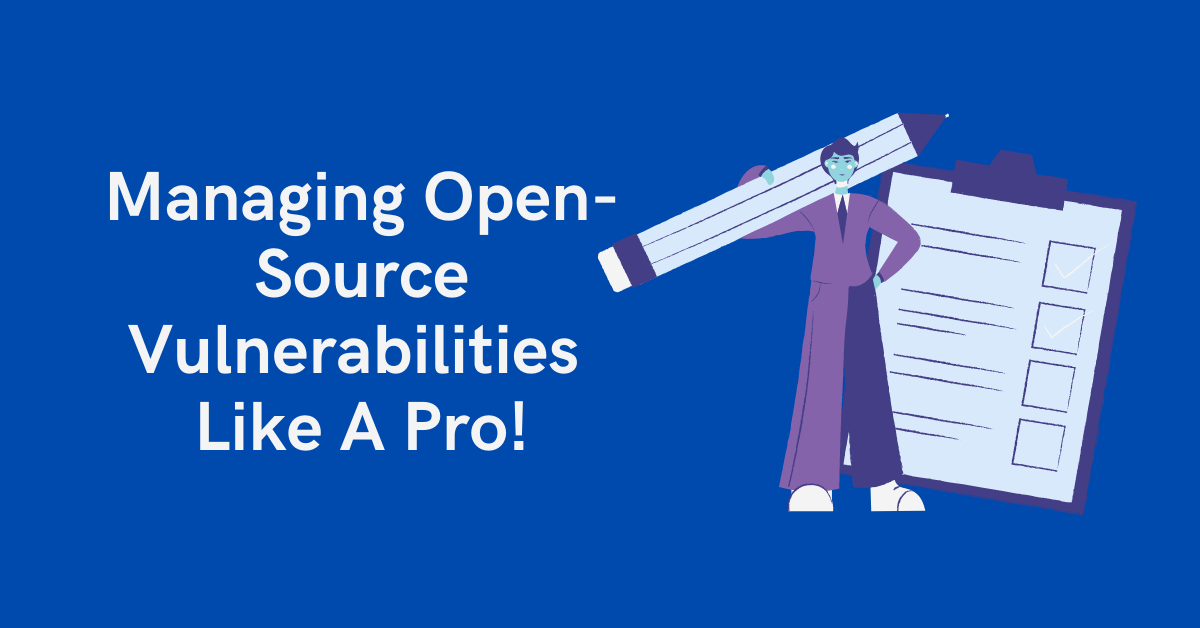Today, I will show you how to manage open-source vulnerabilities like a pro!
Writing code today requires at least some open-source components. A single “import package” adds hundreds of lines of code to your software.
While you cannot control how these open-source components were written, you must understand that any open-source code vulnerability could compromise your software.
Sonatype, in its “State of Software Supply Chain”, reports that one in sixteen open-source components have security defects.
It estimates that an enterprise with 2000 applications would require $7.4 million to remediate even 10 per cent of the defects introduced by these components. This is why it is essential to identify the risks and take action to manage open-source vulnerabilities.
Table of Contents
Detecting Open-Source Vulnerabilities
The best way to identify open-source security vulnerabilities is by using a verified Software Composition Analysis software called SCA. SCAs act as tools that scan any software for its open-source components.
Once this inventory list is made, SCAs scan public and private databases to find known vulnerabilities associated with your software or application.
It then reports the list back to you. While SCAs can detect known vulnerabilities, they are not designed to discover vulnerabilities that are not a part of any database.
This, however, means that they identify the loopholes that hackers are most likely to exploit. The key here is to avoid false positives.
This can be done by combining the concept of reachable vulnerabilities and reachability. This helps to identify which vulnerabilities can be triggered by your application.
Considering the context of potential vulnerability, it is essential to identify and manage your software’s open-source vulnerabilities.
This involves tracking data flow from external input locations to the open-source vulnerabilities and determining which ones are most likely to be attacked.
READ ALSO: 2023 Cybersecurity Maturity Report Released: Why Detecting Cyber Attacks Is Not Enough
Manage Vulnerabilities
JetPatch has pointed out that “According to Fortinet’s “H1 2020 Global Threat Landscape Report,” 74% of manufacturing, energy and utilities, healthcare, and transportation organizations have had a malware intrusion over the past year.” Old vulnerabilities should, therefore, be weeded out.
Here are some ways to stay ahead and avoid open-source vulnerabilities
- Make sure to use SCAs
- This is the easiest and most obvious way to ensure that your open-source vulnerabilities do not affect the application or compromise your security.
- Enforce Policies for Open-Source Use
- Every organization should follow some guidelines when it comes to open-source use. Maintain a committee or entity that can oversee the usage, documentation, and developer responsibility for open-source use.
- Identify Risks
- Scour the National Vulnerability Database and other data sources to identify disclosed vulnerabilities. Make sure to comply with open-source licenses and use up-to-date, high-quality components.
More than 3600 open-source vulnerabilities are discovered annually. This is why it is essential to always keep an eye out for new vulnerabilities and monitor the possibility of any further threats. JetPatch’s platform can help you out there.
This tool can help in security detention, orchestration, and remediation all in one place. It ensures patches for even old or low-priority vulnerabilities and controls your risk profile.
READ ALSO: Cyber Security Or Physical Security – Which Should You Prioritize?
Managing Open-Source Vulnerabilities Like a Pro!
Open-source software (OSS) offers incredible benefits but also introduces risk through potential vulnerabilities. Fear not, security warriors! Here’s your guide to conquering open-source vulnerabilities like a pro:
1. Know Your Inventory
- Identify all OSS in your codebase: Use tools like Snyk, FOSSA, or OpenRef to build a Software Bill of Materials (SBOM).
- Understand their versions and dependencies: Track updates and potential vulnerabilities associated with each component.
2. Prioritize Risk
- Use vulnerability databases: Leverage databases like CVSS (Common Vulnerability Scoring System) to assess severity and prioritize critical vulnerabilities.
- Consider exploitability and impact: To prioritise remediation efforts, factor in the likelihood of an exploit and potential damage.
3. Stay Up-to-Date
- Automate updates: Set up alerts and automated updates for known vulnerabilities wherever possible.
- Manual patching: For non-automated systems, prioritize timely patching based on risk assessments.
READ ALSO: The Role of Edge Networks in Detecting and Defending Against DDoS Threats
4. Monitor Continuously
- Continuous monitoring tools: Implement tools like Snyk Monitor or OSS security platforms to scan for new vulnerabilities.
- Stay informed: Subscribe to security advisories and community forums to stay updated on emerging threats.
5. Build Security In
- Security-first mindset: Integrate security practices throughout the development lifecycle.
- Secure coding practices: Train developers on secure coding practices to minimize vulnerabilities from the start.
6. Leverage the Community
- Engage with maintainers: Report vulnerabilities responsibly and contribute to fixing them when possible.
- Learn from others: Utilize community resources, forums, and best practices to stay ahead of the curve.
READ ALSO: 4 Ways To Improve The IT Infrastructure In Your Company
Bonus Tips
- Invest in security tools: Consider tools like Snyk, WhiteSource, or Dependency-Track for comprehensive vulnerability management.
- Conduct penetration testing: Regularly evaluate your security posture through simulated attacks.
- Build a security culture: Foster a culture of security awareness and responsibility within your team.
A Final Word…
Managing open-source vulnerabilities is an ongoing process, not a one-time fix. By implementing these strategies and staying proactive, you can harness the power of open-source software while minimizing security risks and protecting your organization.
Now go forth and conquer those vulnerabilities with confidence!
NICE READS
- Pros And Cons Of Open Source CMS
- Apple Launches Open-source Password Manager for Developers
- Android releases June 2020 Patches for Critical RCE vulnerabilities
- 5 Ways To Identify Phishing Or Fake Websites
- Full ESET Smart Security Premium Review
- Gift Cards Are Increasingly Popular Among BEC Scammers
- Web Security Guide: Keeping Your Website Safe
- What is Magento? Everything You Need To Know
About the Author:
Daniel Segun is the Founder and CEO of SecureBlitz Cybersecurity Media, with a background in Computer Science and Digital Marketing. When not writing, he's probably busy designing graphics or developing websites.










